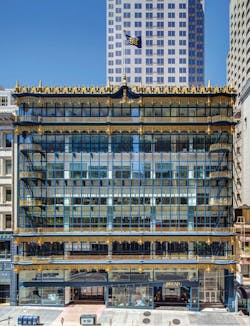Nation's first glass curtain wall exterior restored in San Francisco
When San Francisco’s Hallidie Building opened in 1918, it represented a feat of engineering as well as an exuberant expression of design. Architect Willis Polk devised a seven-story glass façade for the concrete-and-steel office building, then owned by the University of California at Berkeley. The façade, consisting of glass panes suspended in a steel mullion grid, is projected in front of the perimeter columns, with concrete sills supported by bearing anchors to carry the weight of the glass skin. Most of the windows pivot horizontally to facilitate natural ventilation in concert with conventional windows in the wall behind. The building is generally recognized as the forerunner of today’s curtain wall facilities.
Listed in the National Register of Historic Places and the California Register, the Hallidie Building was named a San Francisco Landmark in 1971. Unfortunately, this significant structure showed little of its former architectural glory by the turn of the 21st century. Its original combination of blue paint and gilding—chosen to celebrate UC Berkeley—had faded to a dull gray-green. Elaborate Gothic details, including graceful rounded balconies and ornate friezes, were badly deteriorated. In August 2010, the city’s Department of Building Inspection deemed the structure unsafe, expressing particular concern about unstable metal outriggers supporting balconies and fire escapes.
SIZING UP THE SITUATION
Current owners Ed Conner and Herbert McLaughlin hired The Albert Group to assemble and manage the Building Team, which was led by historic preservation architect Page & Turnbull and project architect McGinnis Chen Associates. The team embarked on a meticulous process of exploratory investigations, conditions assessment, historic research, design, mockups, and fabrication. The work exposed some fundamental design flaws, as well as years of wear and tear.
HALLIDIE BUILDING FAÇADE RESTORATION
San Francisco, Calif.Building Team
Submitting firm: Page & Turnbull (historic preservation architect)
Owners: Ed Conner, Herbert McLaughlin
Project manager: The Albert Group
Architect of record: McGinnis Chen Associates
Structural engineers: Murphy Burr Curry and Toft, De Nevers & Lee
General contractor: Cannon Constructors NorthGeneral Information
Size: Seven-story façade (~9,000 sf with cornice)
Construction cost: $7.1 million
Construction time: Spring 2011 to spring 2013
Delivery method: Design assist with guaranteed maximum priceThough innovative, the façade system did not allow for thermal expansion, leading to warping of some elements. Flashing was inadequate to prevent water intrusion, and numerous window parts had corroded. Structural analysis determined that extra interior bearing and wind anchors would be needed to stabilize the façade.
Many of the basic structural metal shapes used in the original construction—a kit of parts composed of steel angles, T-sections, and plates—were no longer commercially available. A fair amount of fabrication would be required for both the structural and decorative elements. Ornamental pieces, including a roof cornice, striated sheet metal pendants, and stamped zinc frieze panels, were in poor condition, as were many of the steel railings.
The Building Team undertook repairs aiming to retain as much of the historic fabric as possible, while making sure fire-egress features were safe and correcting problems with the original design. An extensive paint analysis was conducted to allow the team to replicate the original bright colors.
BRINGING BACK SAFETY + BEAUTY
To repair the curtain wall, the Building Team replaced vertical support plates, added thermal expansion joints via splice work at the window cover plates, integrated proper flashing, and fixed corroded parts. The deteriorated structural framework supporting the balconies was replaced with steel outriggers and C-channels that were similar in shape and size, and balcony and railing pickets consisting of flat steel bars were either repaired or replaced.
The Building Team was able to repair the decorative sheet metal roof cornice, but the zinc frieze panels, with their detailed plant and bird motifs, proved too fragile to repair with sheet lead as originally planned. Instead, fiberglass—which has a similar coefficient of thermal expansion to zinc—was spray-
applied to the back side of the pieces, allowing more than 90% of the original zinc panels to be stabilized and saved.
Many window sashes were also saved and repaired, using a zinc-rich primer and a high-performance coating system. Others had to be replaced with replicas. All 513 sashes received laminated safety glass—a major improvement over the single-pane originals.
In early May 2013, the completed project was celebrated with a public presentation. The Hallidie Building once again looked the part of an architectural bellwether, stabilized and revived for decades of service. Jay Turnbull, a Principal at Page & Turnbull, said, “Willis Polk’s all-glass façade foretold the modern cityscape by allowing buildings to grow exponentially in scope while incorporating light and air. The Hallidie Building embodies fundamental architectural elements that make the modern city livable, and we all benefit from its example.”



